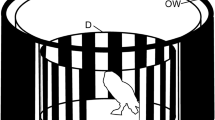Summary
We have investigated the role of ocular accommodation in the distance estimation during pecking in the barn owl (Tyto alba). Owls were trained to peck at pieces of food presented on a small platform (Fig. 2) while one eye was occluded to eliminate binocular distance cues (Fig. 1). The other eye was defocussed by spectacle lenses ( −4, −2, +2 diopters) or had normal vision. Pecking behavior was analyzed by video taping the owl from the side and drawing the owls' head position off-line frame-by-frame. Additionally, during some trials the owls' accommodation behavior was recorded continuously by infrared photoretinoscopy with a second camera. This camera was aligned with the line of sight of the owl so that the refractive state could be measured just prior to pecking. We made the following observations:
-
1.
The lenses resulted in errors in distance estimation which were highly predictable from the power and sign of the lenses (Fig. 3).
-
2.
The lenses also changed the position of the owls' head during the period of fixation (Fig. 4). This finding together with the observation that the owls closed their eyelids during pecking suggested that ‘pecking length’ is a pre-programmed parameter in the owls' pecking behavior (Figs. 5, 6).
-
3.
The photorefractions showed that the owls' accommodative effort during fixation was highly correlated with the power of the lenses. During fixation, negative lenses caused the owl to accommodate more than positive lenses (Fig. 8).
-
4.
The results demonstrate that the accommodative effort necessary to fixate the target is one of the parameters by which the owls can estimate distance (Fig. 9), at least under monocular viewing conditions.
-
5.
The total range of accommodation in the barn owls measured in our experiments did not exceed 6 diopters. This may be one of the reasons why the owls did not get their targets into best optical focus during pecking. The results are discussed with respect to the depth of field in owls and accommodation behavior in other birds.
Similar content being viewed by others
References
Collett TS (1977) Stereopsis in toads. Nature 267:349–351
Collett TS, Harkness L (1982) Depth vision in animals. In: Ingle DJ, Goodale MA, Mansfield JW (eds) Analysis of visual behavior. MIT Press, Boston, pp 111–176
Douglas R, Collett TS, Wagner HJ (1986) Accommodation in anuran Amphibia and its role in depth vision. J Comp Physiol A 158:133–143
Fite K (1973) Anatomical and behavioral correlates of visual acuity in the great horned owl. Vision Res 13:219–230
Goodale MA (1983) Visuomotor organization of pecking in the pigeon. In: Ewert JP, Capranica RR, Ingle DJ (eds) Advances in vertebrate neuroethology. Plenum Press, New York, pp 349–357
Green DG, Powers MK, Banks MS (1980) Depth of focus, eye size, and visual acuity. Vision Res 20:827–835
Harkness L (1977) Chameleons use accommodation cues to judge distance. Nature 267:346–349
Howland H, Howland M, Schmid K, Pettigrew JD (1991) Restricted range of ocular accommodation in barn owls (Aves: Tytonidae). J Comp Physiol A 168:299–303
Jordan M, Luthardt G, Meyer-Naujocks C, Roth G (1980) The role of eye accommodation in the depth perception of common toads. Z Naturforsch 35c:851–852
Martin GR (1982) An owl's eye: schematic optics and visual performance in Strix aluco L. J Comp Physiol 145:341–349
Mathis U, Schaeffel F, Rowland HC (1988) Visual optics in toads. J Comp Physiol A 163:201–213
Murphy CJ, Rowland HC (1983) Owl eyes: accommodation, corneal curvature and refractive state. J Comp Physiol 151:277–284
Pettigrew JD (1989) Is there a single, most-efficient algorithm for stereopsis? In: Blakemore C (ed) Vision: coding and efficiency. Cambridge Univ Press, Cambridge UK, pp 283–290
Pettigrew JD, Konishi M (1976) Neurons selective for orientation and binocular disparity in the visual wulst of the barn owl (Tyto alba). Science 193:675–678
Reymond L (1985) Spatial acuity of the eagle, Aquila audax: a behavioral, optical and anatomical investigation. Vision Res 25:1477–1491
Rossel S (1983) Stereopsis in the praying mantis. Nature 302:821–822
Schaeffel F, Farkas L, Howland HC (1987) Infrared photoretinoscope. Appl Optics 26:1505–1509
Schaeffel F, Glasser A, Howland HC (1988) Accommodation, eye growth and refractive error in chicken. Vision Res 28:639–657
Schaeffel F, Troilo D, Wallman J, Howland HC (1990) Developing eyes that lack accommodation grow to compensate for imposed defocus. Visual Neurosci 4:177–183
Wagner H (1989) Peering in barn owls. In: Erber J, Menzel R, Pflüger HJ, Todt D (eds) Neural mechanisms of behavior. Thieme, Stuttgart, pp 238–239
Author information
Authors and Affiliations
Rights and permissions
About this article
Cite this article
Wagner, H., Schaeffel, F. Barn owls (Tyto alba) use accommodation as a distance cue. J Comp Physiol A 169, 515–521 (1991). https://doi.org/10.1007/BF00193542
Accepted:
Issue Date:
DOI: https://doi.org/10.1007/BF00193542




